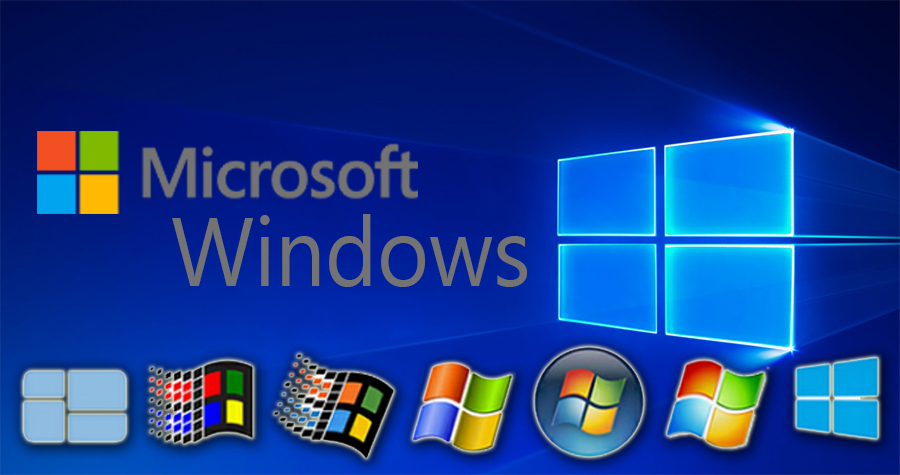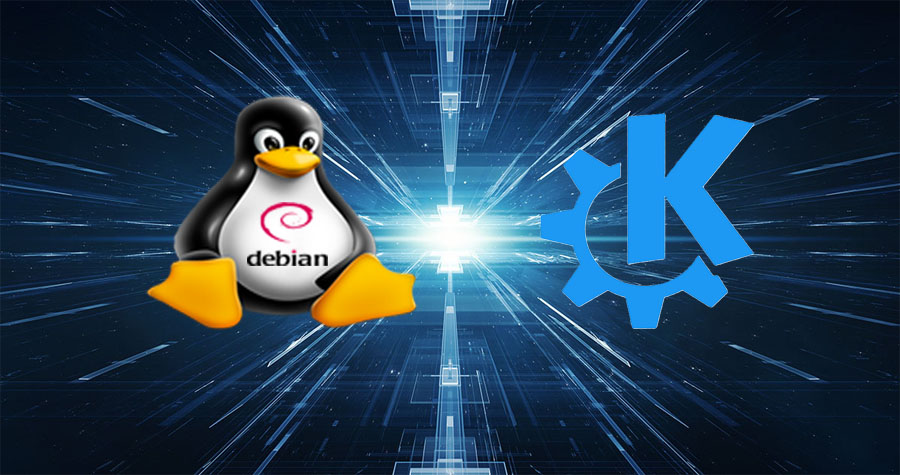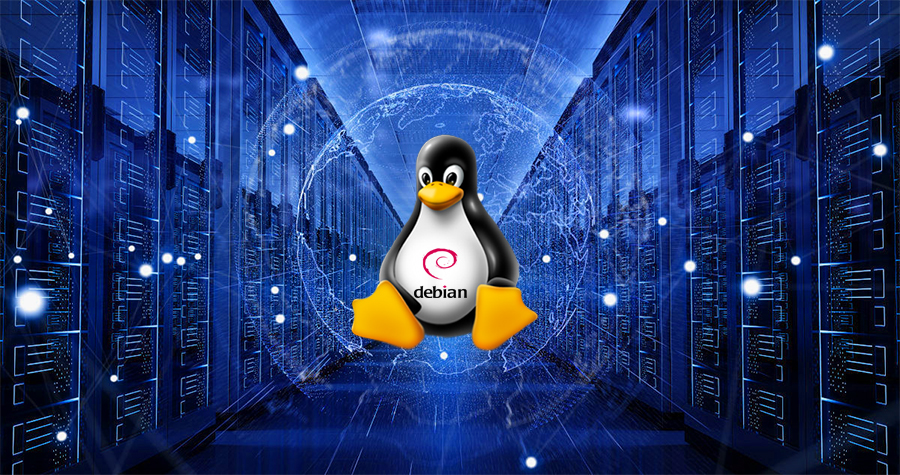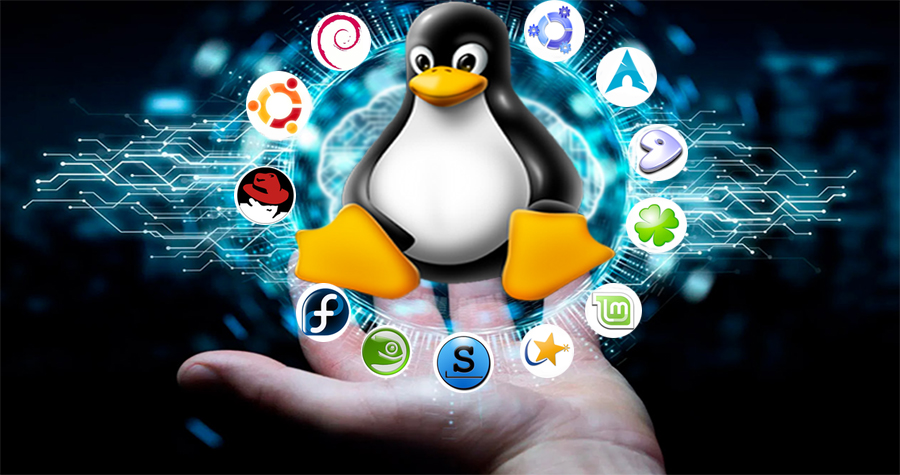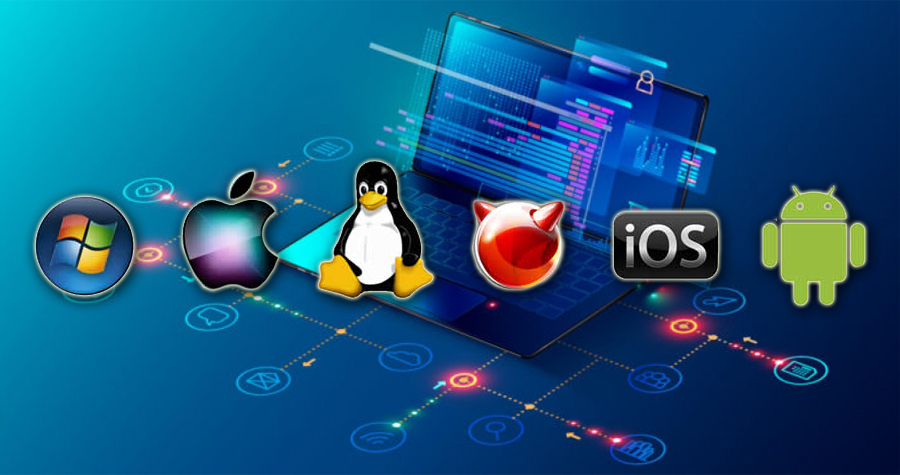Microsoft Windows is the name given to the operating system developed by the software company Microsoft Corporation . It is its flagship product and the one that has made the company one of the largest in the entire digital universe. In this article we will see some introductory details about this operating system.

History of the emergence of Microsoft Windows
Microsoft Corporation was founded on April 4, 1975 by William Henry Gates III ( Bill Gates) and Paul Gardner Allen ( Paul Allen) . The company began by developing BASIC interpreters and Fortran and Cobol compilers; in addition to marketing a variant of Unix 1979 acquired from AT&T through a software license that authorized them to market it under the code name Xenix.
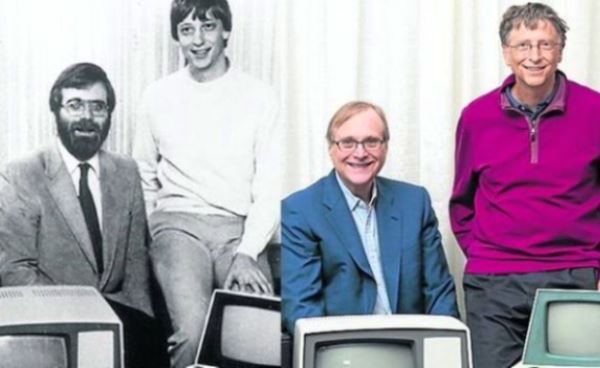
After making agreements with the great IBM (at that time the largest personal microcomputer development company), Microsoft would be in charge of developing the operating system for its computers. In the negotiations, Microsoft reached an agreement to maintain property rights over the operating system. It also maintained the possibility of selling it to other personal computer manufacturers. IBM at that time did not give importance to software, since in those times more value was given to hardware.
Microsoft purchased from a small company called Seattle Computer Products a CP/M clone operating system called Q-DOS (Quick Disk Operating System), also known as 86-DOS , developed by Tim Paterson . After the purchase, Microsoft worked on necessary modifications to meet IBM’s requirements. In 1982 it launched its product MS-DOS 1.0 ( MicroSoft Disk Operating System , Microsoft Disk Operating System ) . After the success of the IBM PC and the great boom in the development of clones of these computers, the most popular and most used operating system was MS-DOS, which launched the small company Microsoft to success.
MS-DOS was a text-mode operating system, which was used through a command interpreter. Following the rise of graphical interfaces developed by the Xerox company and popularized by Apple, Microsoft purchased many of Xerox’s patents including some of the graphical interface and the mouse. He then developed his own graphical interface called Windows.
MS-DOS as an operating system already developed by Microsoft had 8 known versions.
In 1985, on November 20, Microsoft releases Windows as a graphical user interface (GUI) add-on for MS-DOS . Microsoft Windows came to dominate the global personal computer market, with more than 90% of the market share, surpassing Apple’s Mac OS which had been released in 1984.
Until Windows 3.1 the operating system was MS-DOS and Windows was just a graphical interface to interact with this system. From that version onwards it was completely changed and became a fully functional operating system: Microsoft Windows 95.
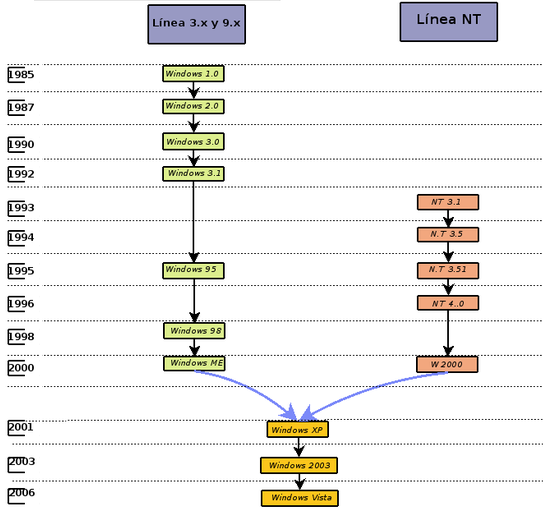
List of versions of Microsoft Windows in its versions for personal computers
| Versión | Año |
|---|---|
| Microsoft Windows 1.0 | 1985 |
| Microsoft Windows 2.0 | 1987 |
| Microsoft Windows 3.x (1-11) | 1990 |
| Microsoft Windows NT | 1993 |
| Microsoft Windows 95 | 1995 |
| Microsoft Windows 98 | 1998 |
| Microsoft Windows 2000 | 1999 |
| Microsoft Windows Millenium (Me) | 2000 |
| Microsoft Windows XP | 2001 |
| Microsoft Windows 2003 | 2002 |
| Microsoft Windows Vista | 2006 |
| Microsoft Windows 7 (Seven) | 2009 |
| Microsoft Windows 8 | 2012 |
| Microsoft Windows 8.1 | 2013 |
| Microsoft Windows 10 | 2015 |
| Microsoft Windows 11 | 2021 |
Microsoft Windows versions for servers
| Microsoft Windows NT Advanced Server 3.1 | 1993 |
| Microsoft Windows NT Server 3.5 | 1994 |
| Microsoft Windows NT Server 3.51 | 1995 |
| Microsoft Windows NT Server 4.0 | 1996 |
| Microsoft Windows Server 2000 | 2000 |
| Microsoft Windows Server 2003 | 2003 |
| Microsoft Windows Server 2003 R2 | 2005 |
| Microsoft Windows Server 2008 | 2008 |
| Microsoft Windows Server 2008 R2 | 2009 |
| Microsoft Windows Server 2012 | 2012 |
| Microsoft Windows Server 2012 R2 | 2013 |
| Microsoft Windows Server 2016 | 2016 |
| Microsoft Windows Server 2019 | 2018 |
| Microsoft Windows Server 2022 | 2021 |
Architecture of the Microsoft Windows family of operating systems
The entire Microsoft Windows OS family is based on the NT Architecture . This architecture, unlike other systems that followed Unix models, was developed focused on modularity and the possibility of providing flexibility like no operating system had. The following image details the distribution of internal components and their way of interacting.
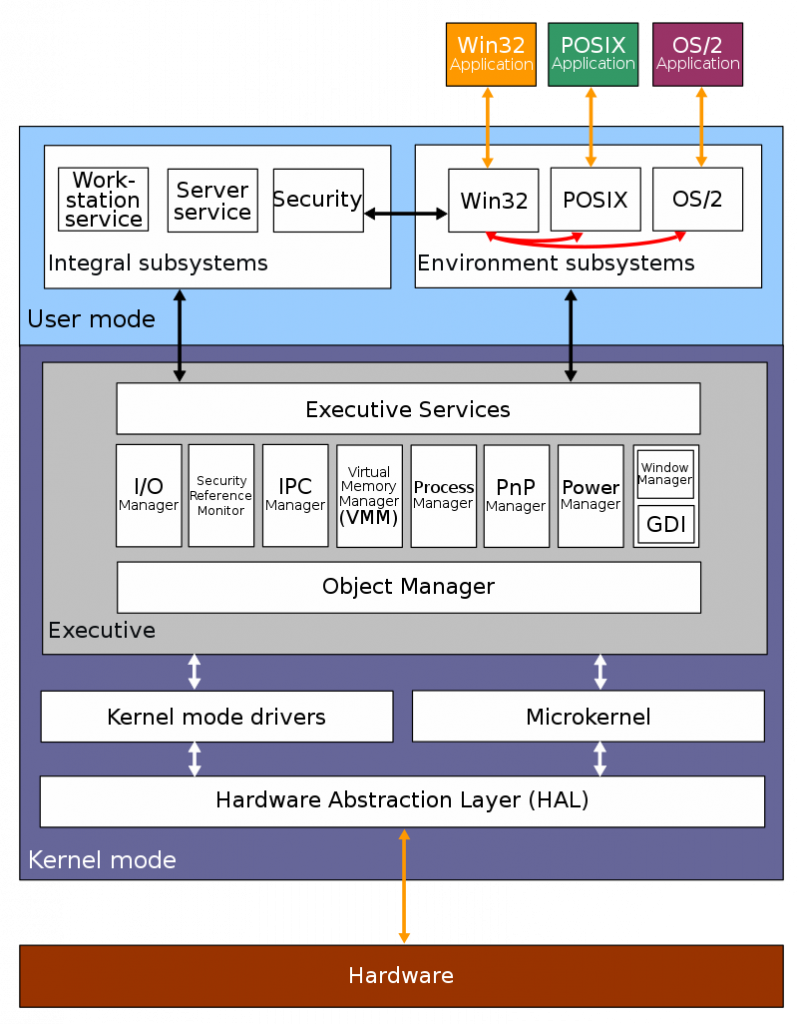
General characteristics of Microsoft Windows systems
- It is the most used operating system on personal computers around the world.
- It is a Centralized System: it is installed as a complete system on a single computer.
- Proprietary Software, distributed in binaries under software licenses that must be paid for.
- Its source code is closed and developed by the Microsoft company; although from time to time they release the code of some of their technologies so that other systems are able to adopt them (AD, ASP .Net, etc.). Internal documentation of the operation of the NT Kernel and its environment is also offered to universities through Windows Research Kernel .
- It has Multitasking, multiprocessor support, and priority management, allowing the execution of multiple tasks (processes and threads) on multiple processors.
- Multi-user, allows the work of several users.
- Simple usability focused on inexperienced users.
- Software Compatible: Most of the software developed is made for this system.
- Preinstalled on devices: many computers already have it installed by default because large manufacturers have agreements with Microsoft.
- It has online support for all users who purchase their license.
- Primary file systems (NTFS and FAT32)
- Graphical shell (Desktop)(Explorer.exe) that simulates a real desktop.
- File explorer integrated into the Shell (Explorer.exe), focused on working in graphical mode (Icons, Windows, bars, menus, buttons, drop-down lists, check boxes, etc.)
- Terminal or console mode shell (cmd.exe)
- High driver compatibility most all manufacturers develop drivers for this operating system.
- Type of executables based on portable executable format, PE (Portable Executable)
- Permission system based on access control lists (ACL: Access Control Lists)
- Automated update system.
- Being the most used operating system, it is the target of attacks, viruses and malicious programs, although in its latest versions it has demonstrated a good level of security, it also includes antivirus (Windows Defender) and Firewall.
- Extensive and available user documentation.
Working modes
In the operating systems of the Microsoft Windows family there have always been several ways of working and it is possible to use them all at the same time if you have all the necessary devices.
Graphic or Traditional mode
Graphical or traditional mode: Using the entire graphical user interface with the keyboard and mouse. Some examples of available options are shown in the 4 images below.
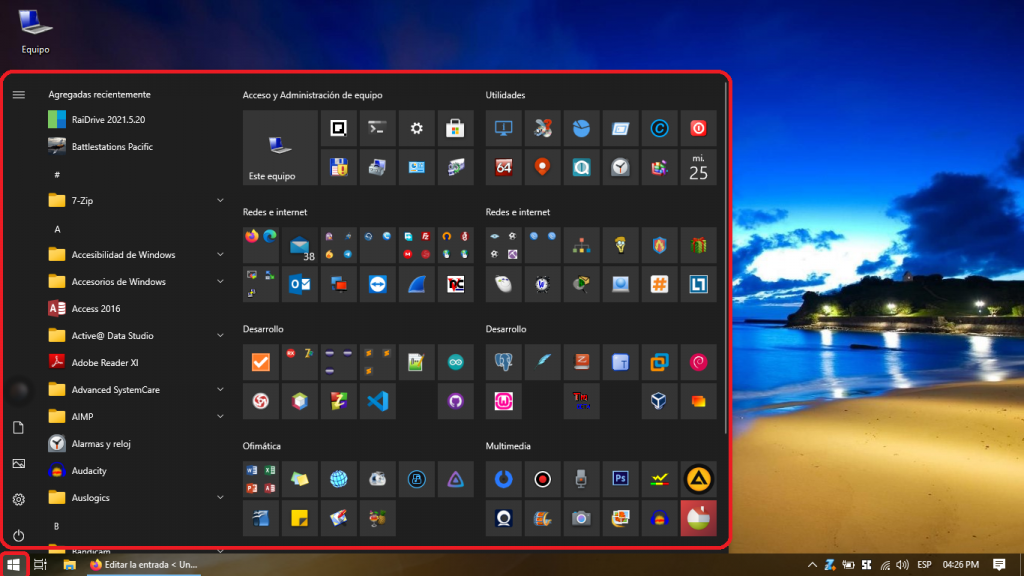

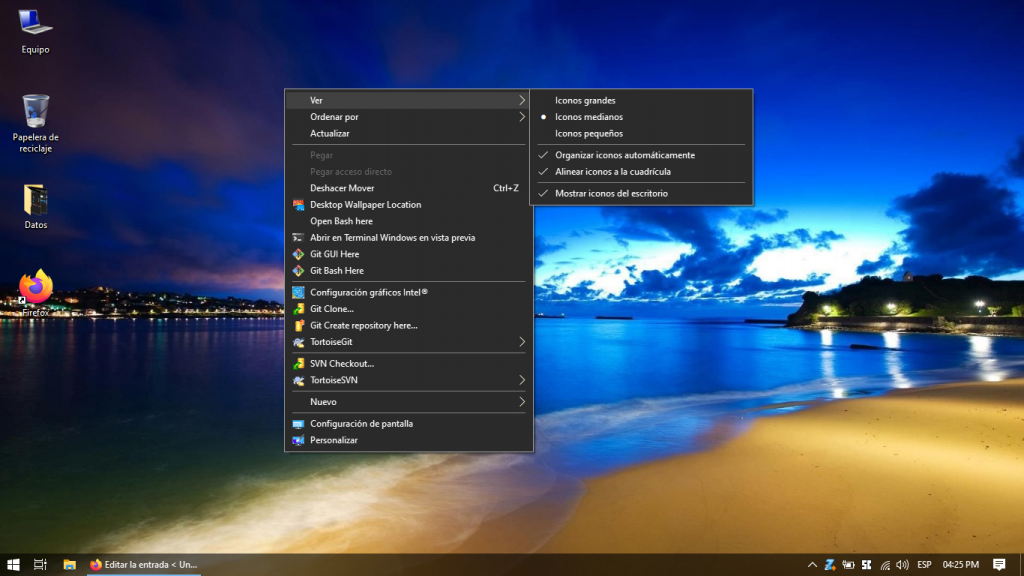
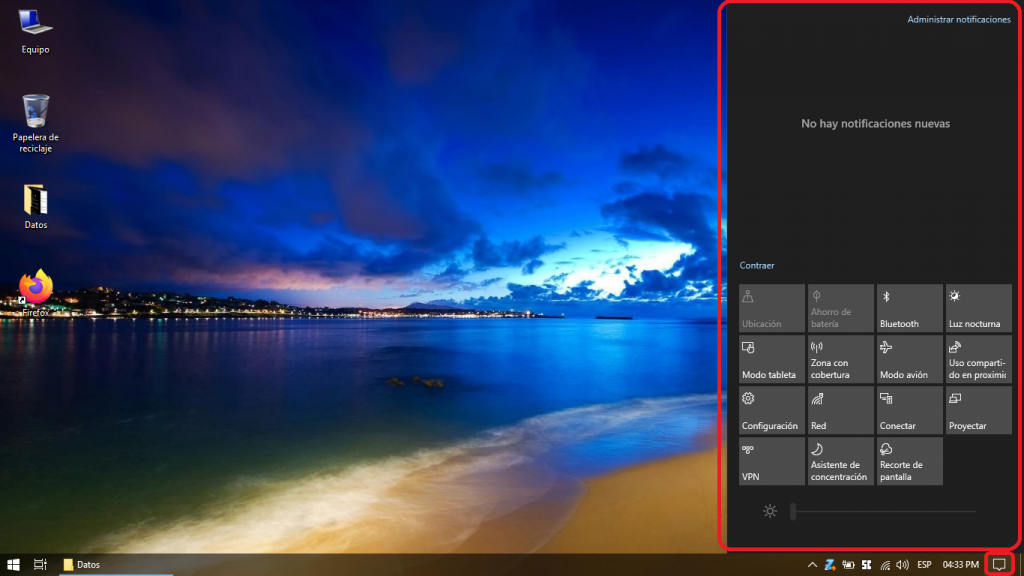
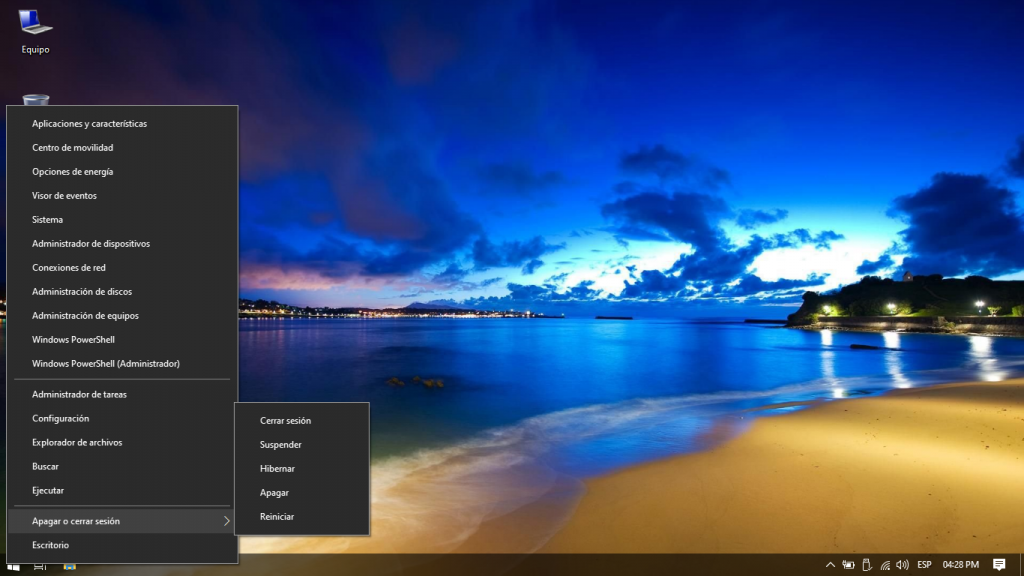
Console Mode or Terminal Mode
The console or terminal mode is the one used when we work from the text mode shell (cmd.exe) or PowerShell, through commands. Windows inherited the commands from MS-DOS and included many others. In Windows it is possible to do almost all the same actions that are carried out through the graphical interface through the command window. This way is usually much more complex to use but sometimes very necessary.
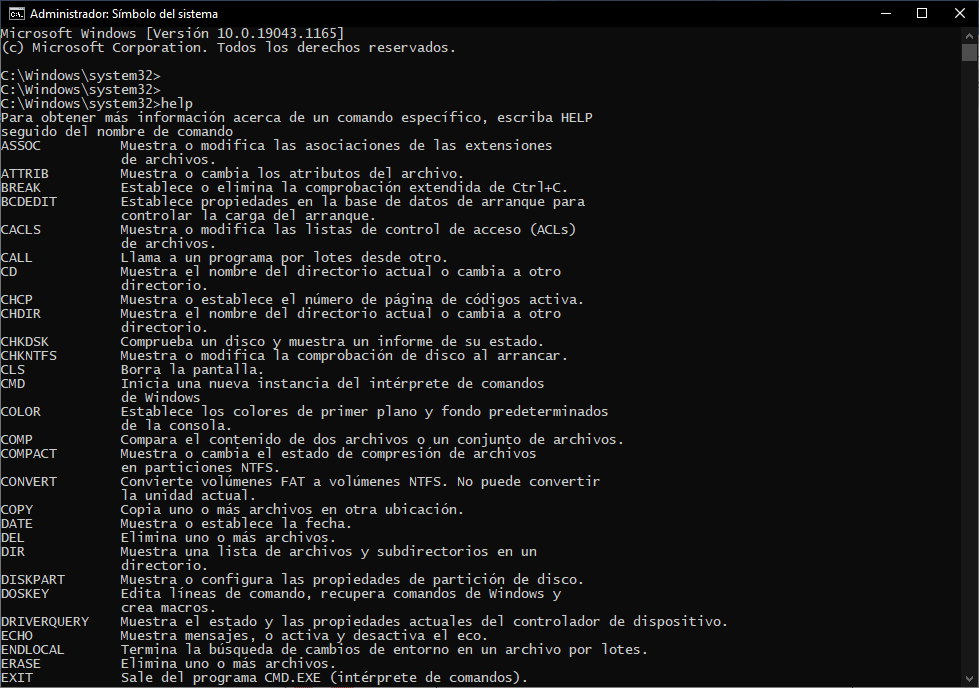

Touch Mode or Tablet Mode
The touch or tablet mode is a new way, very similar to the first, but it is used on devices with touch screens and the hands are used.
Types of windows
The windows managed by the system can be:
- Application (examples: calculator, media player, games, etc.)
- Wizards (installation program windows which have several consecutive screens with next or back options)
- Dialog (File opening windows, save window, select color, select font, configure printer, choose directory, etc.)
- Messages (these small windows show confirmation and information messages, for example the confirmation box that appears when deleting a file)
Access to file systems and disks (Mount Points)
Access to file systems and disks (Mount Points) are assigned automatically, although they can be changed through disk manager. These are identified with letters of the alphabet having C: as the system unit, while A: and B: were used to access floppy disk towers (5 1/4 or 3 1/2). It is also possible to name mount points as folders.
The following image shows the system’s disk manager, the disks and partitions with their respective letters in the cases that are mounted. This window is accessible from the secondary menu of the computer icon by choosing the “Manage” option.
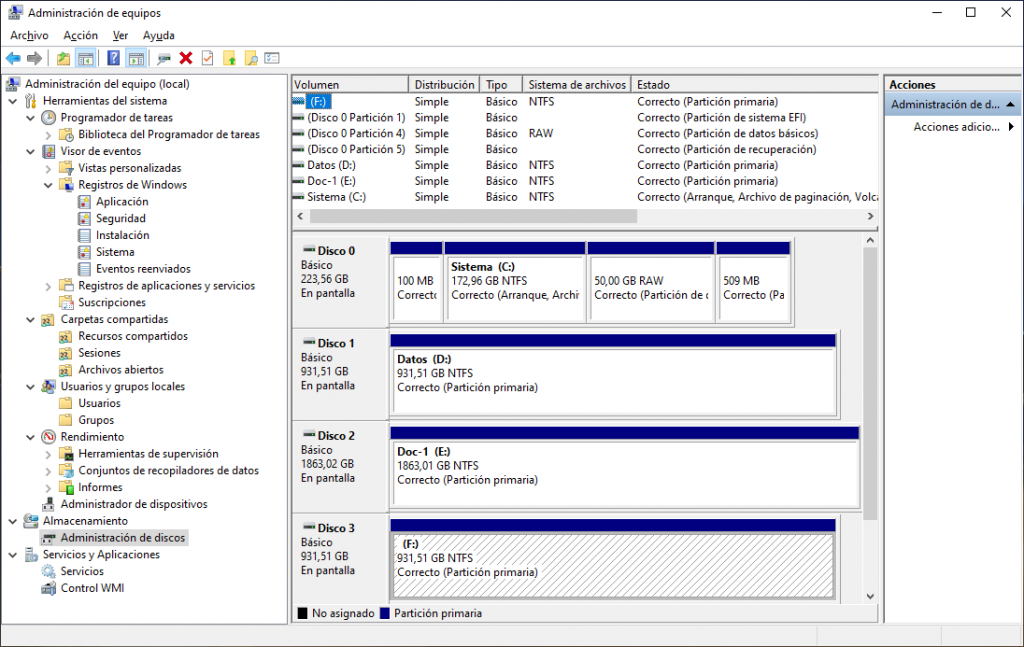
Types of file system elements handled by the operating system
- Directories or folders (Hierarchical container to group information: it can contain any of the types seen in this list)
- Files or archives (Logical data container: it is an interface for accessing related information, for example a document, a song, a video, etc.)
- Shortcut (it is a type of file that its function is to provide a shortcut to a file or folder, but programs cannot traverse it, it is used for users)
- Symbolic link (It is a type of link that is not real, but rather a shortcut to a file or folder. It is similar to shortcuts, but more advanced. Applications are not able to distinguish it from a real folder or file and if they go through or access them, so they are very useful. If we delete this link, it does not really delete the file or folder to which it points)
- Hard link (it is like the symbolic link, but it is not possible to differentiate it. When created it is a pointer to the real directory or file)
- Directory union or Junctions Points (it is similar to the symbolic link, but it is only used for directories)
System directory structure
- Program Files (destination folder for the programs installed by the user)
- Windows (OS folder and system applications)
- Documents and Settings or Users (Folder to save user data and their settings: within this folder one is created for each user who logs into the computer. Within this folder there are some such as Desktop, Documents, Downloads, Music, Videos and others that are specific to each user. In addition, there are other folders that save specific application configurations for each user)
System security
System security is based on users, groups, and policies that define permissions. Group policies can be edited through the gpedit.msc available in the Professional or Enterprise versions. Signatures of drivers, services or applications are also validated. Regarding the files, access control lists are defined which define the permissions on the files.
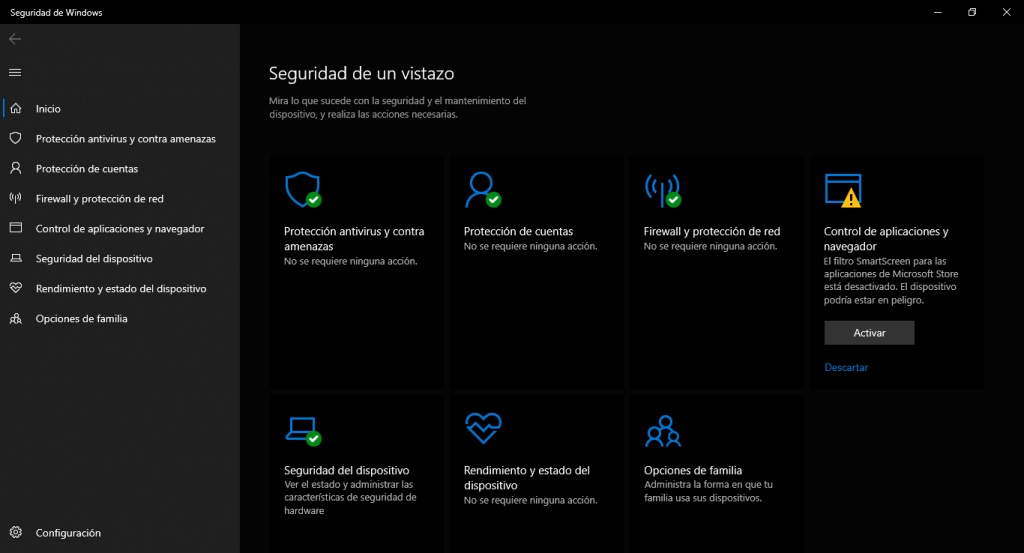
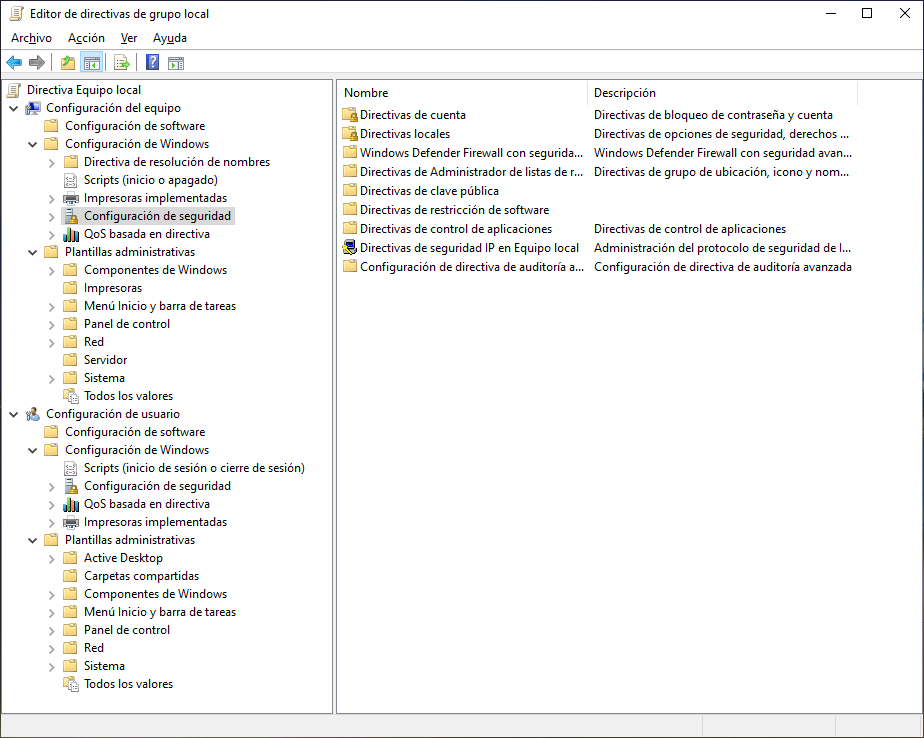
Major Software Utilities Included
- Notepad (Text Editor)
- Paint (Drawing Program)
- Calculator
- Characters map
- On-screen keyboard
- Windows Media Player
- Wordpad (Rich Format Text Editor)
- Sound recorder
- Image or photo viewer
- Speech recognition
- land
- Storyteller
- Cortana Assistant
- Software Store (Microsoft Store)
- Maps
- Edge Browser
- Alarms and clock
- Calendar
- Camera
System configuration and customization
Changes to configurations and customizations can be made in several ways, the easiest is through the “Settings” option, which is available in the start menu.
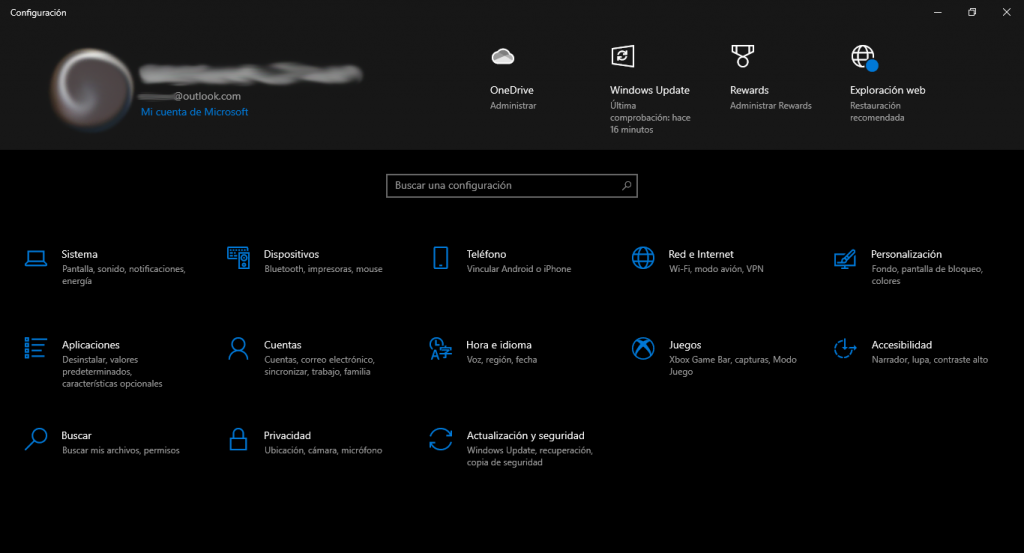
A second variant that is easy to configure and customize is through the Control Panel.
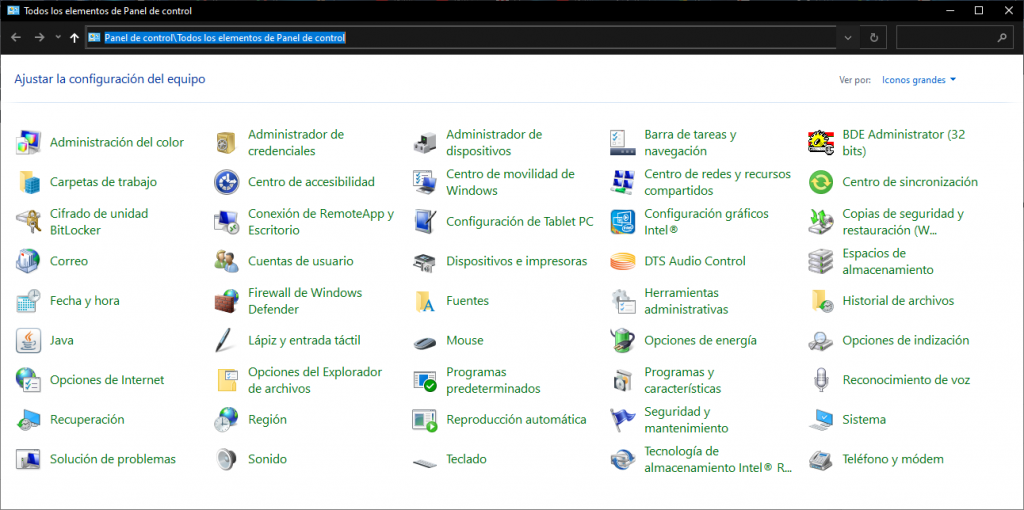
Another variant to change the settings through the team management window accessible from the team icon secondary menu is by choosing the Manage option.
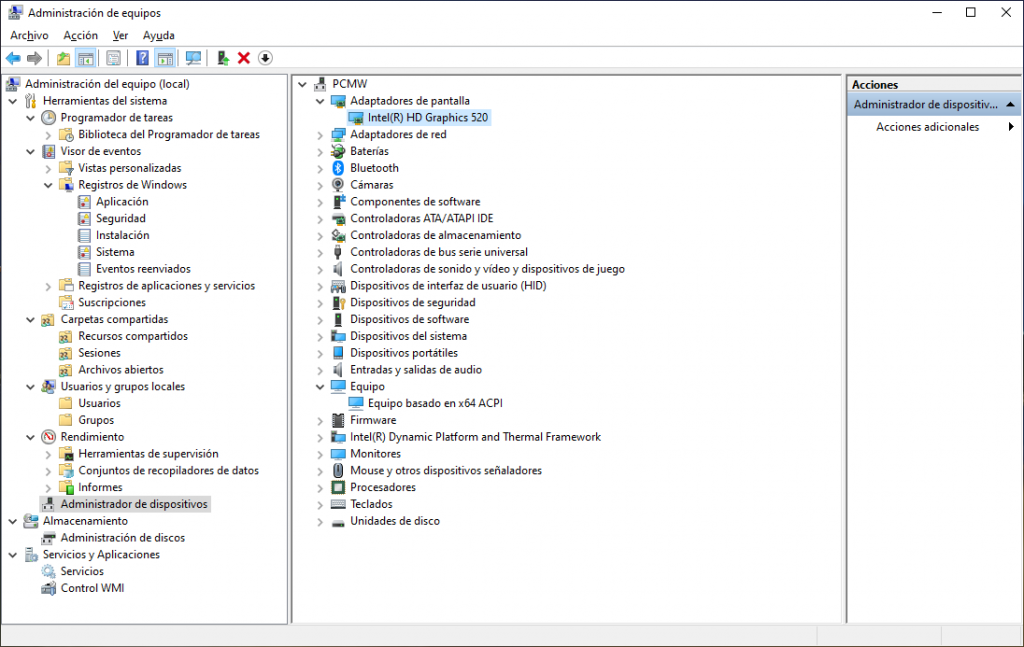
Another way to change slightly more advanced settings is the System Registry, which is accessible by typing “regedit.exe” in the run window that can be launched by pressing the Win + R keys.
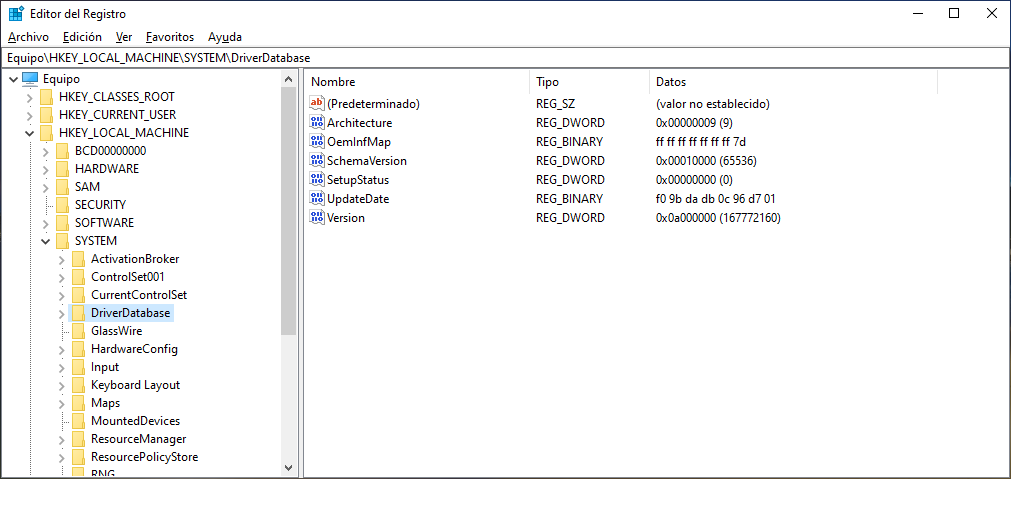
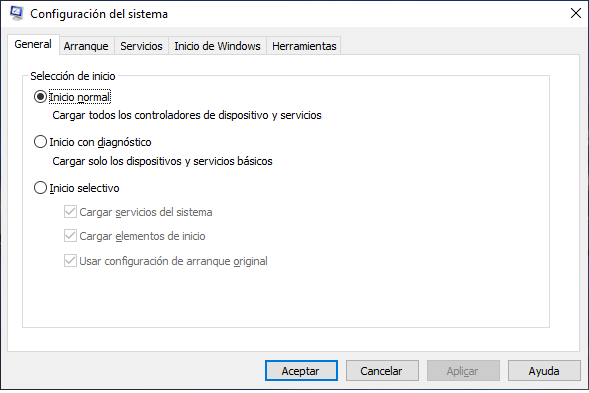
Global key combinations available in Windows 10
| Key combination | Result |
| Ctrl + Alt + Del | Show global session and task manager options. On some keyboards the Delete key may appear as Delete |
| Win | Open or close the start menu |
| Win + A | Show the notification panel and quick actions |
| Win + B | Display in the notification area if there are hidden icons |
| Win + C | Launch the Cortana window |
| Win + D | Show the desktop |
| Win + E | Launch file explorer |
| Win + H | Start dictation with voice recognition |
| Win + I | Open the configuration window |
| Win+K | Launch the connect window to connect remote displays |
| Win+L | Block the user section |
| Win + M | Minimize everything |
| Win + Shift + M | Restore Minimized |
| Win + P | Open the panel to configure output to displays and projectors |
| Win + Q | Open search window |
| Win + R | Launch the run window |
| Win + S | Open search window |
| Win + T | Allows you to select between open tasks in the taskbar |
| Win + U | Open the Ease of Access Center |
| Win + V | Launch the clipboard if your history is activated |
| Win + X | Open advanced start menu |
| Win + Pause Break | Show equipment properties window |
| Win + Shift +S | Take a screenshot |
| Win + Tab | Switch between open windows |
| Win + Alt + D | Show/Hide time and calendar panel |
| Win + Ctrol + Q | Open quick assistance window |
| Win + . | Open the emoji panel |
| Win + “+” | Open Magnifying Glass |
| Win + Arrows | Locate the window on the screen |
| Win + Space | Shows the option to switch between keyboard languages |
| Win + Ctrl + Enter | Enable system narrator |
| Win + PrtScr | Take a screenshot and send it directly to the images folder |
| Win + Number | Switch to the app corresponding to that app number if it is open or pinned to the taskbar |
| Alt + Tab | Switch between open windows |
| Alt + F4 | Close current window |
| Alt + Shift | To switch between keyboard languages, both Alt and Shift must be left |
| Alt + Underlined letter | Activate any command that has it, it can be buttons or menus, for example “File” would be activated by pressing the Alt + A key |
| Ctrl + Shift + Esc | Open the task manager |
| Ctrl + C | Copy depending on the application you are working on |
| Ctrl + X | Cut depending on the application you are working on |
| Ctrl + V | Paste depending on the application you are working on |
| Ctrl + Z | Undo depending on the application you are working on |
| Ctrl + Y | Redo depending on the application you are working on |
| F1 | Open help depending on the application you are working on |
Windows File Explorer
The following image shows the file explorer. It can be launched using the Win+E key combination or by double clicking on its icon.
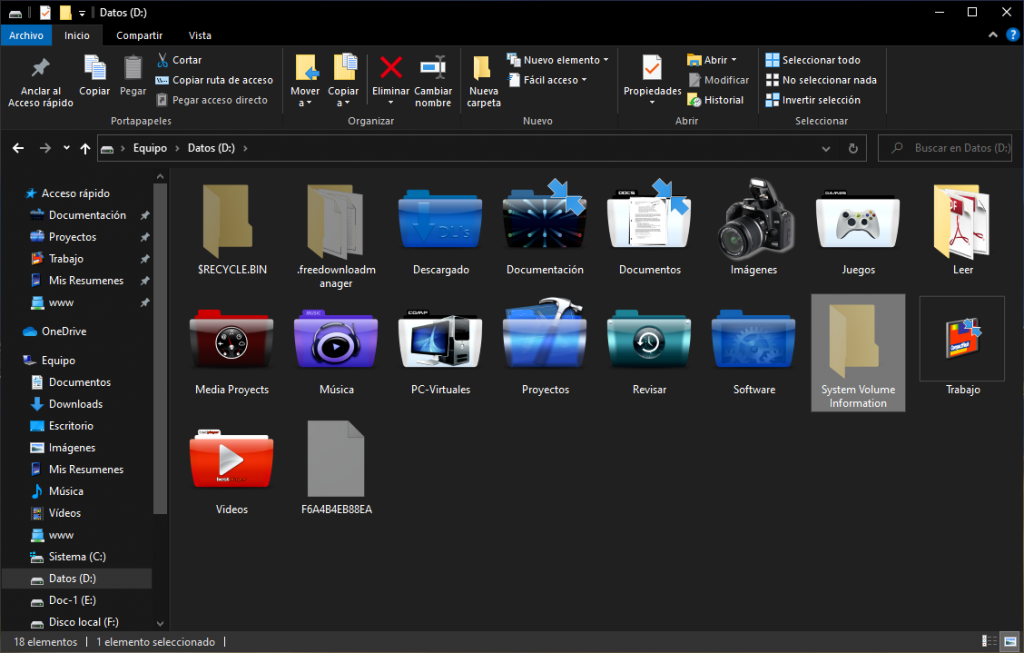
Key combinations available in file explorer
| Ctrl + Shift + N | Create new folder in current location |
| Ctrl + C | Copy files or folders |
| Ctrl + X | Cut files or folders |
| Ctrl + V | Paste files or folders |
| Of the | Delete files or folders by sending them to the recycle bin |
| Shift + Del | Delete files or folders permanently |
| F2 | Rename file or folder |
| F3 | Search files or folders |
| F4 | Select address bar |
| F5 | Reload location (Update) |
| F10 | Select the menu bar |
| Ctrl + E | Select all (if the system is installed in Spanish, otherwise it would be A) |
| Alt + Enter | Show the properties window of the selected element |
| Backspace | Return to top folder |
Other operating system applications
Windows Task Manager : can be launched from various locations or by pressing the Ctrl+Shift+Esc key combination
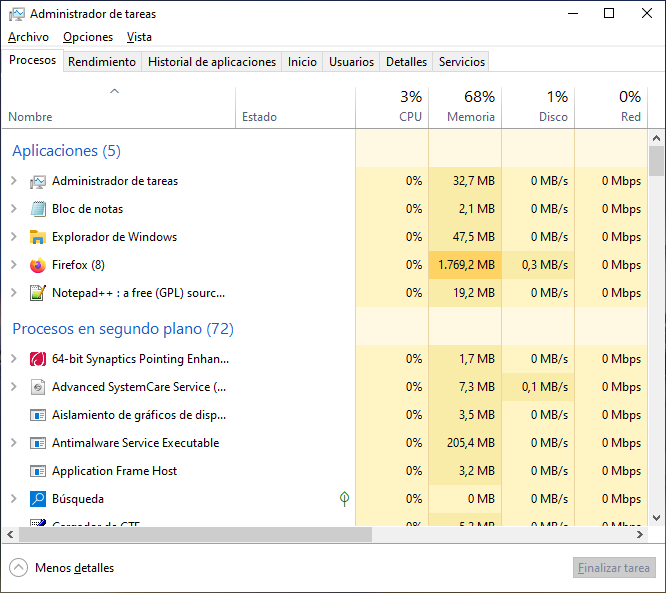
Microsoft Store Application (Software Store): From this application it is possible to install applications very easily and safely.
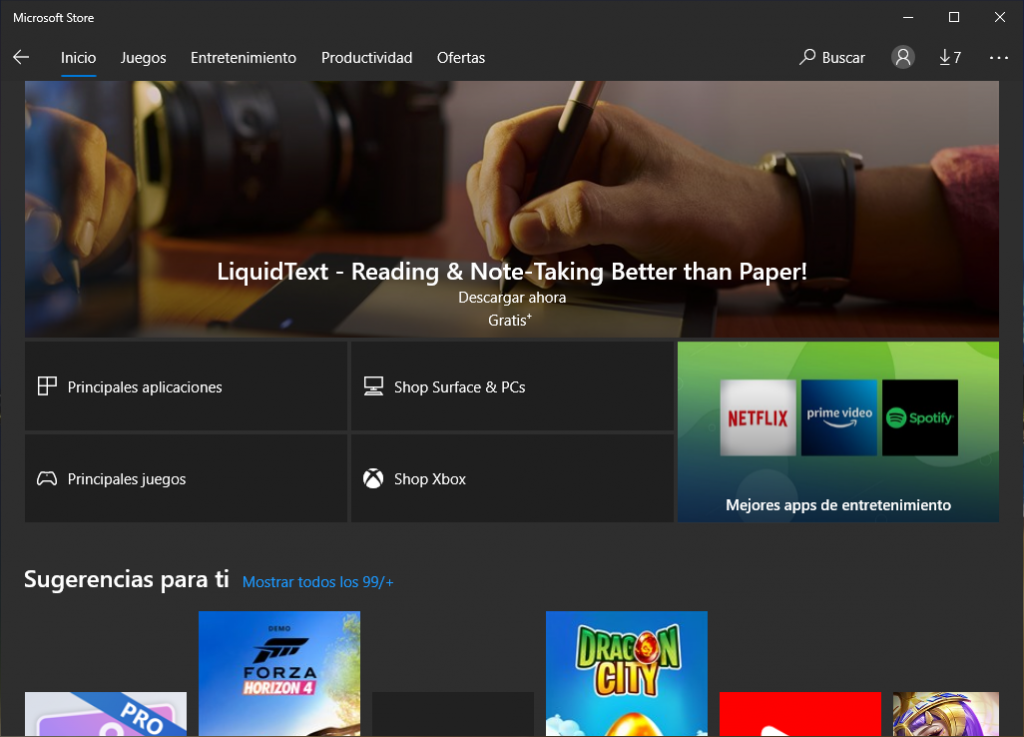
At this point you, dear reader, should have a good idea of the main characteristics of the operating systems of the Microsoft Windows family. If you have questions or suggestions, you can leave your comment or write through any of the dissemination channels ( Telegram or Facebook ).


